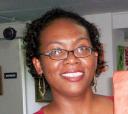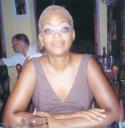By Alim Hosein
(This week, Alim Hosein reviews the work of the Guyana Women Artists Association exhibited at a special show mounted in honour of International Women’s Day (March 8) 2008 at the Centre of Brazilian Studies in Georgetown. Alim Hosein is a linguist, an artist, a critic of art and literature and has been a fine art correspondent associated with the Sunday Stabroek Arts. He is attached to the Division of English in the Department of Language and Cultural Studies at the University of Guyana.)
 The Guyana Women Artists Association (GWAA) has to be ranked as one of the most consistent and long-lived artist groups in Guyana. The association actually comes out of a long history of women-artist groups functioning in then British and now independent Guyana. In fact, women can be found among the exhibitors from the art exhibitions in Guyana during the early decades of the last century, and women artists were present in the first local exhibition in 1930. After a lapse in such involvement in the art scene, a significant revival occurred in April 1988 when the Guyana Women Artists Association was launched.
The Guyana Women Artists Association (GWAA) has to be ranked as one of the most consistent and long-lived artist groups in Guyana. The association actually comes out of a long history of women-artist groups functioning in then British and now independent Guyana. In fact, women can be found among the exhibitors from the art exhibitions in Guyana during the early decades of the last century, and women artists were present in the first local exhibition in 1930. After a lapse in such involvement in the art scene, a significant revival occurred in April 1988 when the Guyana Women Artists Association was launched.
In the book, Sixty Years of Women Artists in Guyana which is a significant publication that accompanied the revival, Nesha Haniff gives information which points to the sizeable involvement of women in fine art exhibitions in the 1930s and 40s.
Not only was the women’s involvement sizeable, but it had depth too: they participated in various genres: watercolour, oils, pen and ink, craft, etc. In 1998, to mark its tenth anniversary, the association included a historical segment in its exhibition, in which it displayed some amazingly well-preserved pieces done by women, and dating from as far back as 1910.
 This year, the association quietly marks its 20th year. Although it chose not to mark this fact but to honour International Women’s Day in an exhibition of work at the Brazilian Cultural Centre, its members and moving personalities must be congratulated for making the GWAA exhibitions something that art-loving Guyanese can look forward to each year. In doing this, of course, the GWAA has been helping to keep art alive in this country. Long-standing artists such as Ms Agnes Jones, former principal of the Burrowes School of Art, and O’Donna Allsopp, Irene Gonsalves and Elizabeth Deane-Hughes whose works had been exhibited at the 1988 exhibition and onwards, are still involved and exhibiting with the group.
This year, the association quietly marks its 20th year. Although it chose not to mark this fact but to honour International Women’s Day in an exhibition of work at the Brazilian Cultural Centre, its members and moving personalities must be congratulated for making the GWAA exhibitions something that art-loving Guyanese can look forward to each year. In doing this, of course, the GWAA has been helping to keep art alive in this country. Long-standing artists such as Ms Agnes Jones, former principal of the Burrowes School of Art, and O’Donna Allsopp, Irene Gonsalves and Elizabeth Deane-Hughes whose works had been exhibited at the 1988 exhibition and onwards, are still involved and exhibiting with the group.
Others such as Nyota Killikelly, Anna Correia, Akima Mc Pherson, Margaret Dookhun, Beverly Reynolds and Norma Woolford have become artists closely connected to the association over the years.
What is excellent also, is the fact that the women have shown growth in their personal work. Gonsalves has long established herself as one of the finest ceramists in Guyana, and her work carries an unmistakable stamp of quality. This is seen in the conceptualisation, execution and finish of each piece, not to mention the fact that her output is prolific. Amazingly, quality does not suffer in favour of quantity.
In similar vein is Correia who has excellently taken up the mantle of her illustrious mother, ceramist Stephanie Correia. But Correia has gone further and has over recent exhibitions exhibited other work. This year, she displays some interesting pen and ink, crayon and watercolour pieces.
Deane-Hughes has in the past exhibited jewellery among other kinds of work. This year her small, photographic mixed-media conceptual pieces share a similar jewel-like quality.
One thing that is missing is the abundance of offerings, which often typified GWAA exhibitions of the past. Unlike previous years when the exhibition abounded in paintings, ceramics, textiles, paperwork, jewellery and other offerings, the 2008 exhibition is decidedly more austere. However, while the range of work that women are capable of is missing, the relative restraint leads to an exhibition, which has greater evenness of quality, and that quality is very high indeed.
All the pieces match one another in level of execution and conceptualisation, and so create an exhibition of good strength. But variety is not wholly missing – while most of the exhibition consisted of paintings, the painting styles are different, the themes are also different, and different artists made use of different media. Lisa Thompson’s mixed-media tables add a decorative and functional note to the exhibition, and her other mixed-media pieces add a new dimension in her use of materials.
Another fine hallmark of the association is that it always has new members on show. In some cases, these are foreign women artists living in Guyana for a temporary period of time in which case they often open a window to different and new themes and ways of creating art, or they may be young Guyanese women who are trying to establish themselves as artists.
This year, Lori-Ann Jacobs, Thompson and Dominique Hunter have added their contribution to the history.
Jacobs is a student of Fine Art at the University of Guyana and she has been pursuing an expressive line of work, which focuses on the human figure.
Hunter’s work is more tranquil and pursues the richness of shape, colour and texture in nature.
It was an exhibition to honour women, and indeed, in more ways than one, it did just that. One looks forward to the GWAA going from strength to strength.









